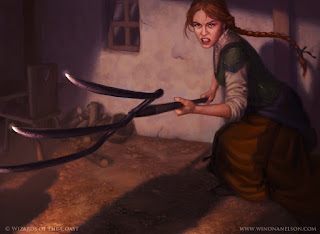I’m always trying to think of ways to streamline and simplify rules and mechanics. Well, that’s not really true, usually I’m trying to think of something else (Should gorilla-men who live in treehouses and dump their waste to the forest floor have any special immunities or bonuses to save against the spores and disease of the fungus-people who collect the waste?) and then I get on a mental tangent and spend the rest of the day wondering why only Thieves have skills and why they are use a percentage die system while every other dice mechanic in the damn game is a d6 or d20.
More systems means more complication and more distractions during the game as players stop and ask which die they roll for a particular thing, and I find that terribly annoying. On the other hand, using a single die or mechanic for every single thing is boring and usually ends up with dice pools and all the bullshit and headaches that entails.
I like to keep it simple, yet interesting.
So I was thinking about the Prime attribute system in Castles and Crusades. It was created to simplify saving throws and skills by making them attribute checks. A Prime atribute means you have to roll 12 or better, a Secondary attribute means you have to roll an 18 or better. The GM also has modifiers (difficulty levels) that they can throw at your roll but that’s the gist of it.
The problem is that I’ve run Castles and Crusades before, and the players were constantly confused as to which attribute was prime and what they roll and what their bonus was and… the campaign fizzled. I thought maybe it was my fault, I didn’t explain the system well enough… blaming myself, really.
It wasn’t me though. The SIEGE system (what C&C calls their mechanic) is cluncky and weird and doesn’t work all that well when you look at it closely.
Sure, some skill might be under one of your Prime attributes, but since you’re the wrong class, you don’t get to add your level to it. Or, you are the right class, but you don’t have the right Prime attribute so you suck at something you should be good at. And why does every system want to front-load badassness into every character at 1st level? I remember back in the day all these hipster scumbags shitting on Rifts for front-loading characters and now every game does it. First level characters should be shit, and they should become slightly less shit as they gain experience.
Especially if you aren’t playing a superhero RPG.
When is someone going to publish a perfect system that I won’t have to rewrite?
Anyway… here is Saves and Skills
I believe characters should be built over time, hence the entire point of experience points and levels. Some games and players don’t use xp or levels. This isn’t for you.
Saving throws
Basically the same as C&C, but the terminology is removed because it is unnecesary.
To save, roll 18 or higher on a d20. Include all applicable modifiers. The GM (me) can add modifiers to indicate the difficulty of the situation. For example, the HD of a spellcaster is added to the dificulty of any saves against that spellcaster’s magic. Or an invisible trap will be harder to detect than an obvious hole in the ground.
If your character is a…
- Warrior: You get +6 to Strength based saves
- Magic User: You get +6 to either Intelligence or Wisdom saves (Player’s choice)
- Specialist: You get +6 to Dexterity based saves
All characters get to choose two other attributes. The saves from each of these attributes have a bonus of +3.
Every level your character goes up, you get a +1 to ALL saves.
Skills
Skills doesn’t just mean the special skills of the specialist. Skills are pretty much anything not covered by a saving throw. For that reason, I’m not including a skill list.
To successfully roll a skill, you have to roll an 18 or higher on a d20.
Warriors and Magic Users focus on fighting and magic. Therefore they are not as adept at things not involving those two things.
- Warriors and Magic Users add attribute modifiers to applicable skills.
- This gives Warriors and Magic Users a 10% chance of success at first level, not including attribute bonuses.
- Warriors and Magic Users have the possibility of selecting a “Class Skill,” which gives a particular skill the bonus of +1 per level of the character.
Specialists are all about skills. That’s the strength of the class!
- Specialists receive a +3 to all skills, in addition to applicable attribute modifiers
- Specialists receive a bonus of +1 per level of the character to all skills.
- This gives the Specialist a 25% chance of success at first level, not including attribute bonuses.
Special note about Languages
- Regardless of class, the Intelligence modifier indicates how many languages the character can speak and read, in addition to their native language.
- There is no maximum number of Languages a character can know.
- The Language skill is used to determine if the character knows a particular language when it is encountered for the first time. It is rolled as any other skill.













![Reblog this post [with Zemanta]](http://img.zemanta.com/reblog_e.png?x-id=5296ded5-e993-408a-a7db-40e92224a742)